Thesis
For decades, software development has required a deep stack of technical knowledge: spinning up environments, configuring build pipelines, managing deployment infrastructure, and debugging across layers. While new frameworks and cloud tooling have improved ergonomics in the 2000s-2010s, the core process remained inaccessible to most people. Even for experienced engineers, setting up a new project still meant bouncing between IDEs, terminals, and documentation.
The release of ChatGPT in November 2022 catalyzed the next interface shift. Large language models (LLMs) proved capable of writing code, answering technical questions, and helping build simple applications. As models improved in 2023 and 2024, usage of AI-native coding assistants surged. In 2023, McKinsey estimated that LLMs could generate $4.4 trillion in annual economic value, and in 2024, Google reported that over 25% of its new code was written by AI. In Y Combinator’s Winter 2025 batch, 25% of startups generated 95% of their codebase using AI, despite being highly technical teams.
By 2025, this shift had a name. Coined by Andrej Karpathy and popularized across tech circles, “vibe coding” describes the emerging workflow of prompting instead of programming. The developer describes what they want, and the system builds it. Among founders, designers, PMs, and even seasoned engineers, prompting has become the fastest way to create new software. The critical skill is no longer typing perfect syntax, but shaping intent, debugging AI output, and having the taste to know when it’s good enough to ship. As Karpathy put it in a February 2025 post on X:
“There's a new kind of coding I call ‘vibe coding’, where you fully give in to the vibes, embrace exponentials, and forget that the code even exists. It's possible because the LLMs (e.g. Cursor Composer w Sonnet) are getting too good. Also I just talk to Composer with SuperWhisper so I barely even touch the keyboard. I ask for the dumbest things like "decrease the padding on the sidebar by half" because I'm too lazy to find it. I "Accept All" always, I don't read the diffs anymore. When I get error messages I just copy paste them in with no comment, usually that fixes it. The code grows beyond my usual comprehension, I'd have to really read through it for a while. Sometimes the LLMs can't fix a bug so I just work around it or ask for random changes until it goes away. It's not too bad for throwaway weekend projects, but still quite amusing. I'm building a project or webapp, but it's not really coding - I just see stuff, say stuff, run stuff, and copy paste stuff, and it mostly works.”
One of the earliest products to embrace this shift is Bolt, developed by the team at StackBlitz as an extension of their core platform. Bolt turns natural language prompts into fully deployed, full-stack web applications, running entirely in the browser with no setup, servers, or cloud infrastructure. By combining the latest AI models with its proprietary WebContainers technology, Bolt avoids the cost and complexity of cloud IDEs while enabling real-time, production-grade app generation. As CEO Eric Simons put it: “The entire software world order is getting rewritten”, and Bolt is an early preview of what that rewrite looks like.
Founding Story
StackBlitz was founded in 2017 by Eric Simons (CEO) and Albert Pai (CTO) in San Francisco. The pair, both natives of Chicago, met in their teenage years and started coding together. Their early work resulted in ClassConnect, an education startup they launched in 2011 after being accepted into Imagine K12, an accelerator for K–12 startups.
Imagine K12 was renting office space in AOL’s headquarters in Palo Alto, giving Simons 24/7 badge access. After ClassConnect’s initial funding ran out, Simons secretly lived in AOL’s offices for over four months. Eventually, a security guard discovered him sleeping there and kicked him out. ClassConnect shut down, and in 2013, the founders moved on to build Thinkster, an online coding education platform. During that same period, Simons and Pai lived in a shared room at a Seattle frat house for $100 per month while bootstrapping the company. Thinkster was acquired in January 2019 by Joe Eames, a developer and educator based in Salt Lake City.
Through Thinkster, Simons and Pai saw how difficult it was for beginner programmers to set up local development environments — many churned before writing their first line of code. StackBlitz was launched in 2017 as a browser-based integrated development environment (IDE) built on VS Code, that supported frontend Angular and React apps.
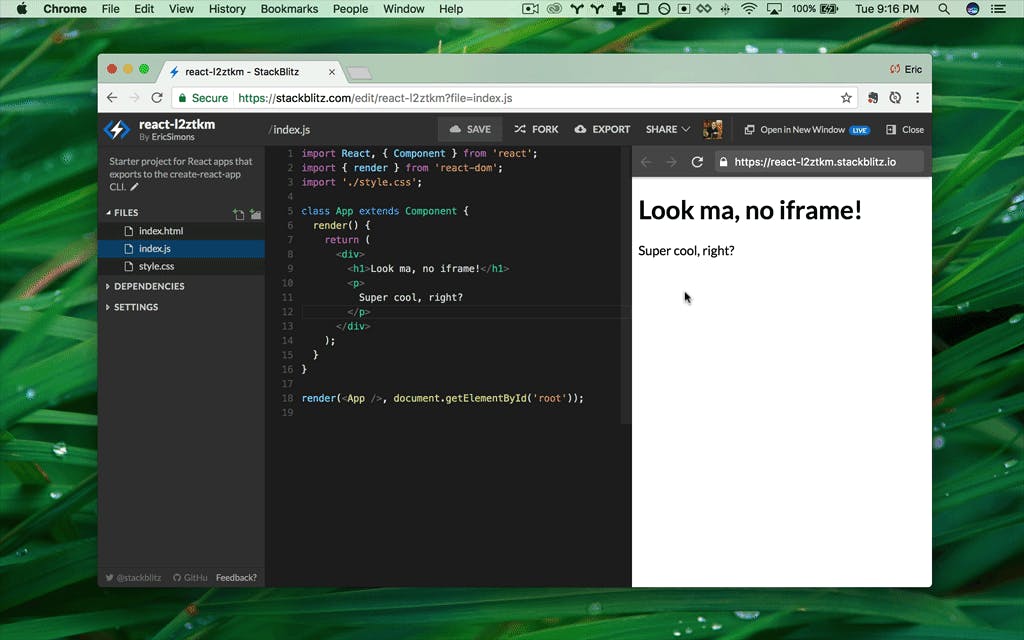
Source: Eric Simons via Medium
Unlike traditional online IDEs that rely on remote servers, StackBlitz ran entirely on the user’s device using local compute. This architecture delivered faster load times and a smoother programming experience. It took the team over four years to build the core WebContainer infrastructure that enabled full-stack development directly in the browser. StackBlitz was adopted by engineering teams at Google, Cloudflare, and Uber for debugging and was used by projects like SvelteKit to build interactive tutorials. The company’s earliest hires were power users of the platform, many of whom remain on the team as of March 2025. By 2022, StackBlitz had reached 2 million monthly active users, most of them using the platform for free.
By late 2023, StackBlitz was exploring new directions. While the core technology had strong adoption, the team hadn’t found a clear path to monetization. One idea under consideration was layering generative AI on top of the platform, allowing users to generate code through LLM calls. Simons and Pai prototyped Bolt in February 2024, but shelved the idea due to limitations in model performance. In June 2024, they gained early access to Anthropic’s Sonnet 3.5 — the first model capable of making the experience work. They committed to the build in July and launched the product in October. Within two months after launching, it had scaled to $20 million in ARR.
Product
Bolt.new is powered by two technologies developed by the StackBlitz team: the StackBlitz IDE and WebContainers. Together, they enable full-stack application development entirely within the browser, without using remote servers, virtual machines, or cloud-based infrastructure. This architecture is what makes Bolt fast, cost-efficient, and capable of running real development environments in a single browser tab.
Stackblitz
StackBlitz is a browser-based IDE built for frontend application development. It mimics the experience of desktop tools like VS Code, but runs entirely in the browser. Developers can open a project, install dependencies, write code, and preview results instantly without needing to install Node.js, npm, or any local tooling. The IDE supports core JavaScript frameworks such as React, Angular, and Vite, and integrates with GitHub, Chrome DevTools, and real-time previews. It also includes enterprise features like SSO, private npm registry support, and offline or on-premise deployments for larger engineering teams.
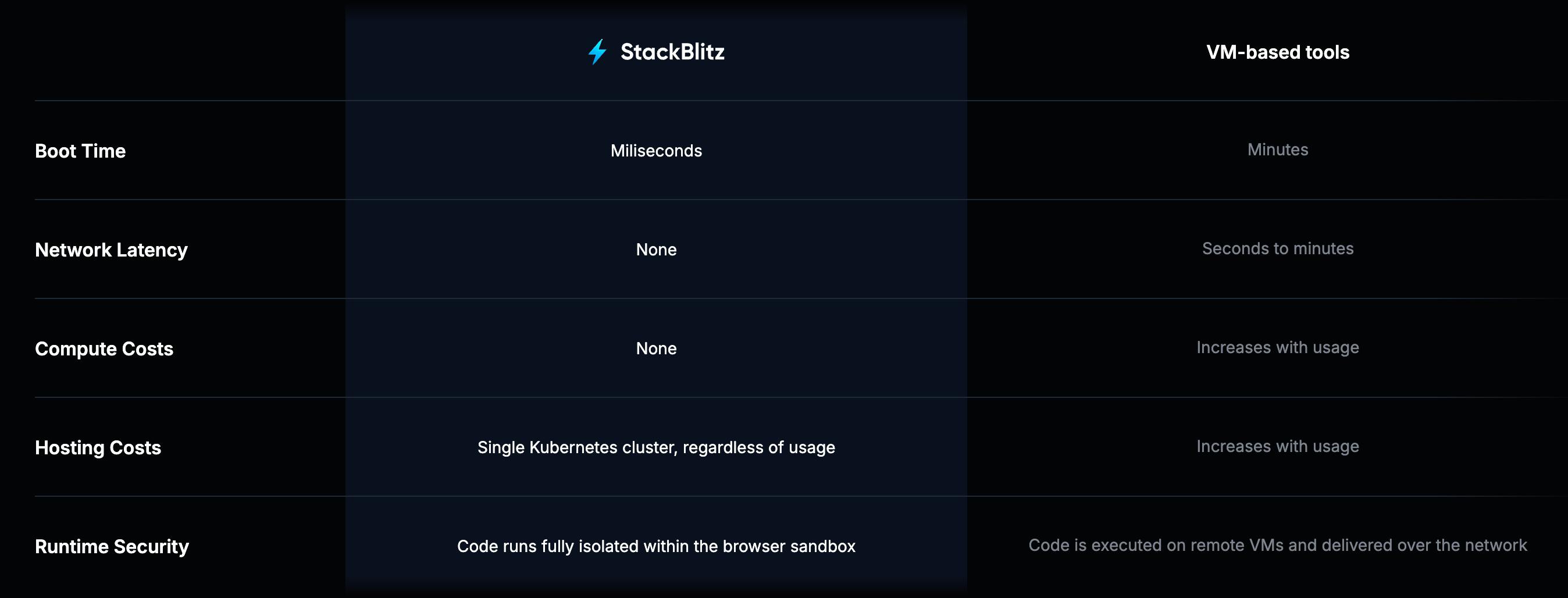
Source: Stackblitz
StackBlitz is used by engineering teams at companies like Google, Meta, Shopify, and Stripe for tasks like debugging, sharing reproducible environments, and building interactive tutorials. Open-source frameworks like SvelteKit rely on it to power in-browser tutorials and code sandboxes. By 2024, StackBlitz had grown to over 3 million monthly active users.
WebContainers
WebContainers are the core infrastructure behind StackBlitz. They simulate a full Node.js environment directly inside the browser using WebAssembly. This allows developers to install and run npm packages, spin up development servers, and write full-stack applications with no backend infrastructure required.

Source: WebContainers
Unlike traditional cloud IDEs that stream development environments from a remote server, WebContainers run entirely on the user’s device. This means faster boot times, lower latency, and no server costs. From a security standpoint, everything is sandboxed within the browser, reducing attack surfaces and eliminating risks associated with cloud-based VMs. WebContainers are also available as a standalone API, allowing other platforms to embed instant developer environments into their products. This unlocks new use cases for developer tools, onboarding flows, documentation, and educational platforms that require real-time code execution in a browser.
Bolt.new
Bolt is an AI-native interface that turns natural language prompts into fully deployed, full-stack applications. Built on top of StackBlitz and WebContainers, it runs entirely in the browser using local compute. When a user submits a prompt, Bolt routes it through Anthropic’s Sonnet 3.5, an LLM trained on high-quality code and reasoning data. The model generates application code and the system processes it through a middleware layer that tracks file changes, handles package installations, and orchestrates third-party integrations. The goal is to replicate the workflow of a full-stack developer.
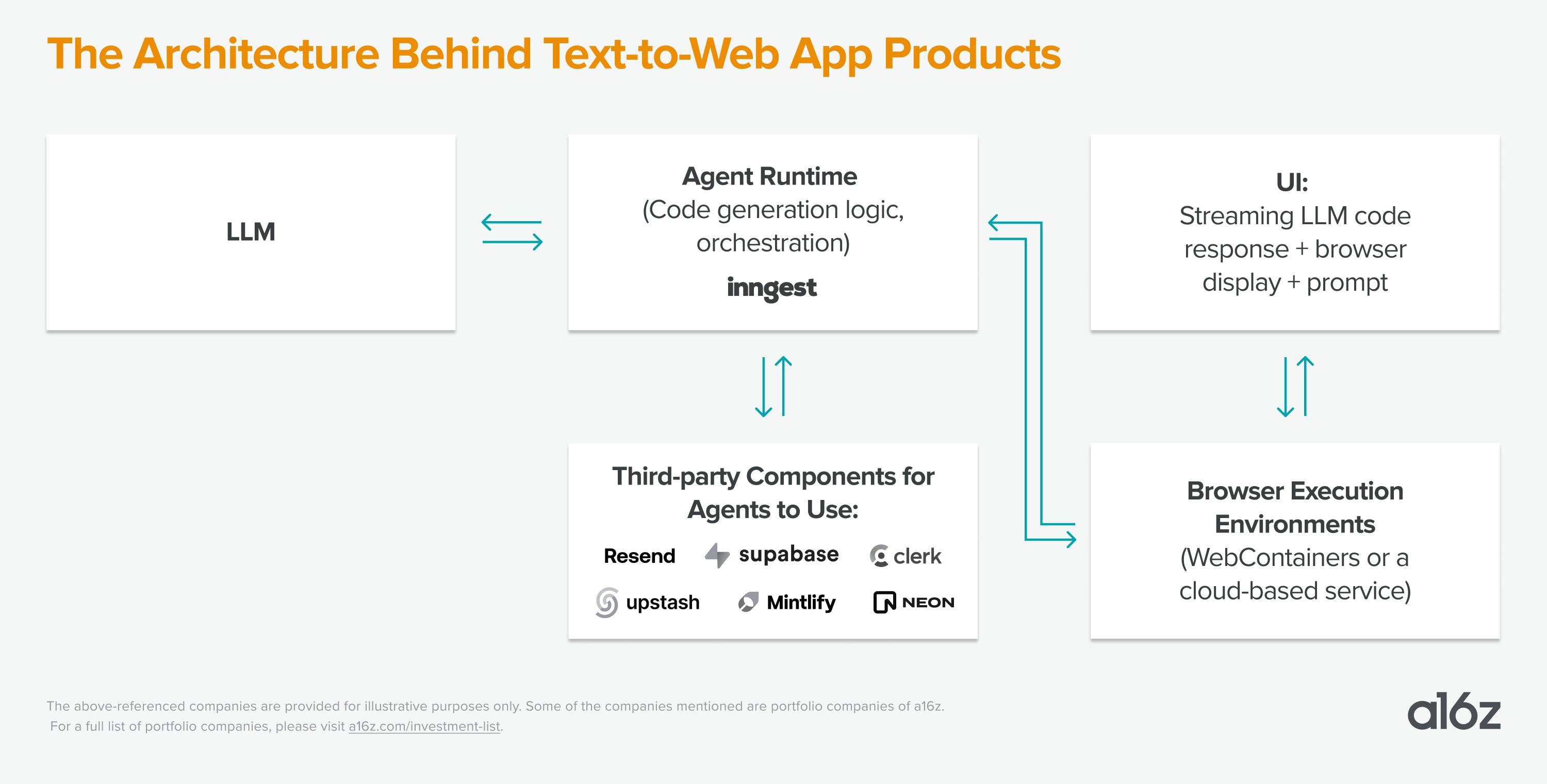
Source: a16z
A key component of Bolt’s system is third-party integration. Rather than building authentication flows or database logic from scratch, Bolt integrates directly with tools like Supabase for data and authentication, and deploys instantly to Netlify. This approach reduces error rates and makes the apps production-ready by default. Browser runtimes and frontend-heavy architectures further reduce complexity, making it possible to render, test, and deploy apps in minutes.
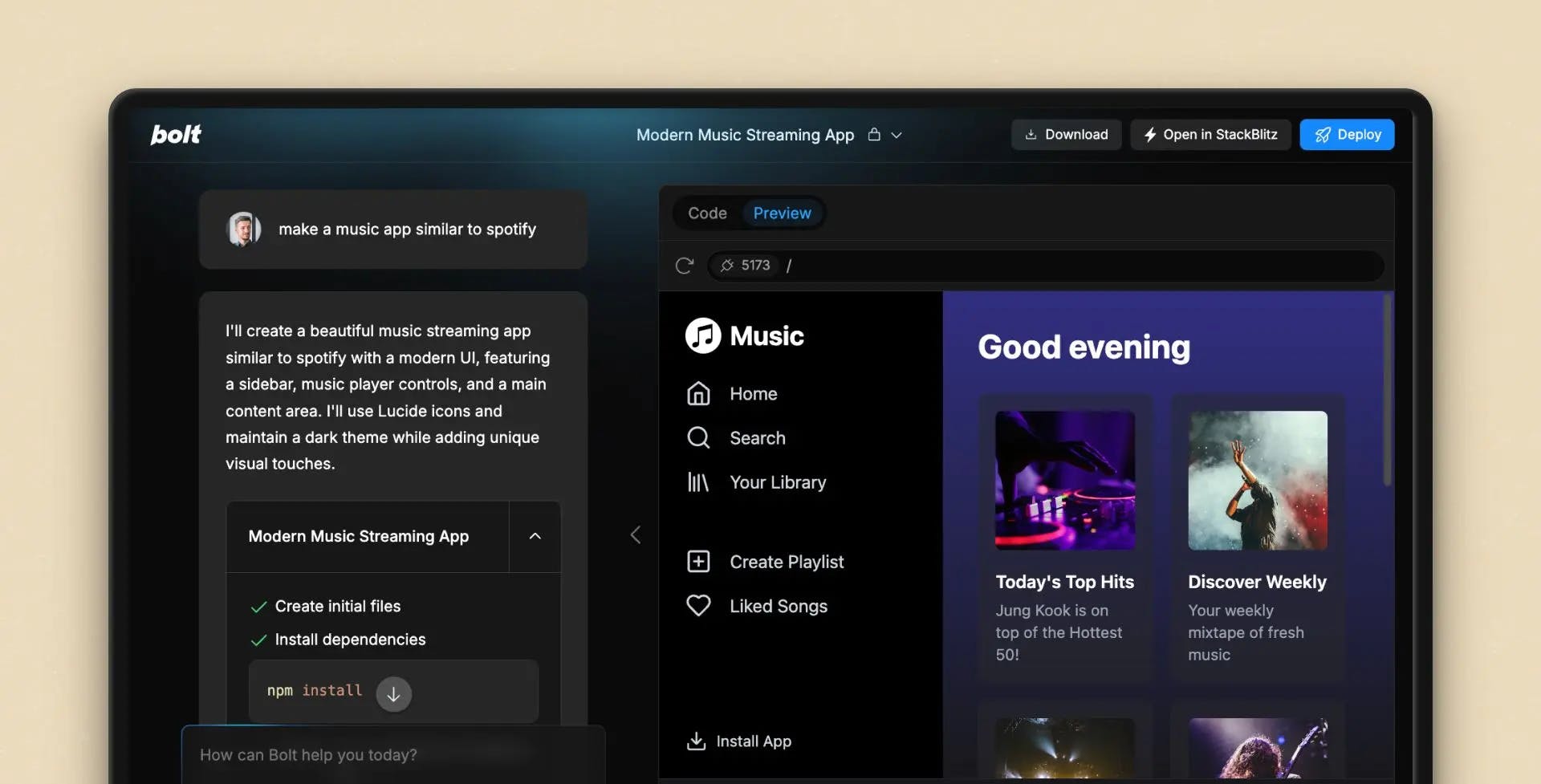
Source: Anthropic
The experience is fully interactive. Users type in prompts like “Build a CRM with user authentication and contact tracking,” and Bolt generates a complete React + Vite project, wired to a Supabase backend. The user can iterate by prompting changes (“add a dark mode,” “connect Stripe”), while the system manages dependency updates and file rewrites behind the scenes. This enables a wide range of use cases — from building marketing sites and dashboards, to spinning up CRMs and internal tools. Users can start from a blank prompt or iterate on existing apps by describing changes in plain language.
In February 2025, Bolt launched native mobile app support, allowing users to build and deploy mobile applications using the Expo CLI tool. As of March 2025, Bolt integrates with Figma, enabling designers to convert their projects into full-stack applications. As of April 2025, Bolt offers a usage-based pricing model, charging users for the LLM tokens they consume rather than a flat subscription. This model aligns pricing with output, giving casual users a low-cost entry point while allowing power users to scale up without limits.
Market
Customer
Consumers
As of March 2025, roughly 67% of Bolt’s users were non-developers: entrepreneurs, designers, product managers, or anyone with an idea for a software application. These users rely on Bolt to build everything from marketing pages and landing sites to functional MVPs, without touching a line of code. It replaces tools like Webflow by offering a simpler interface and deeper functionality.
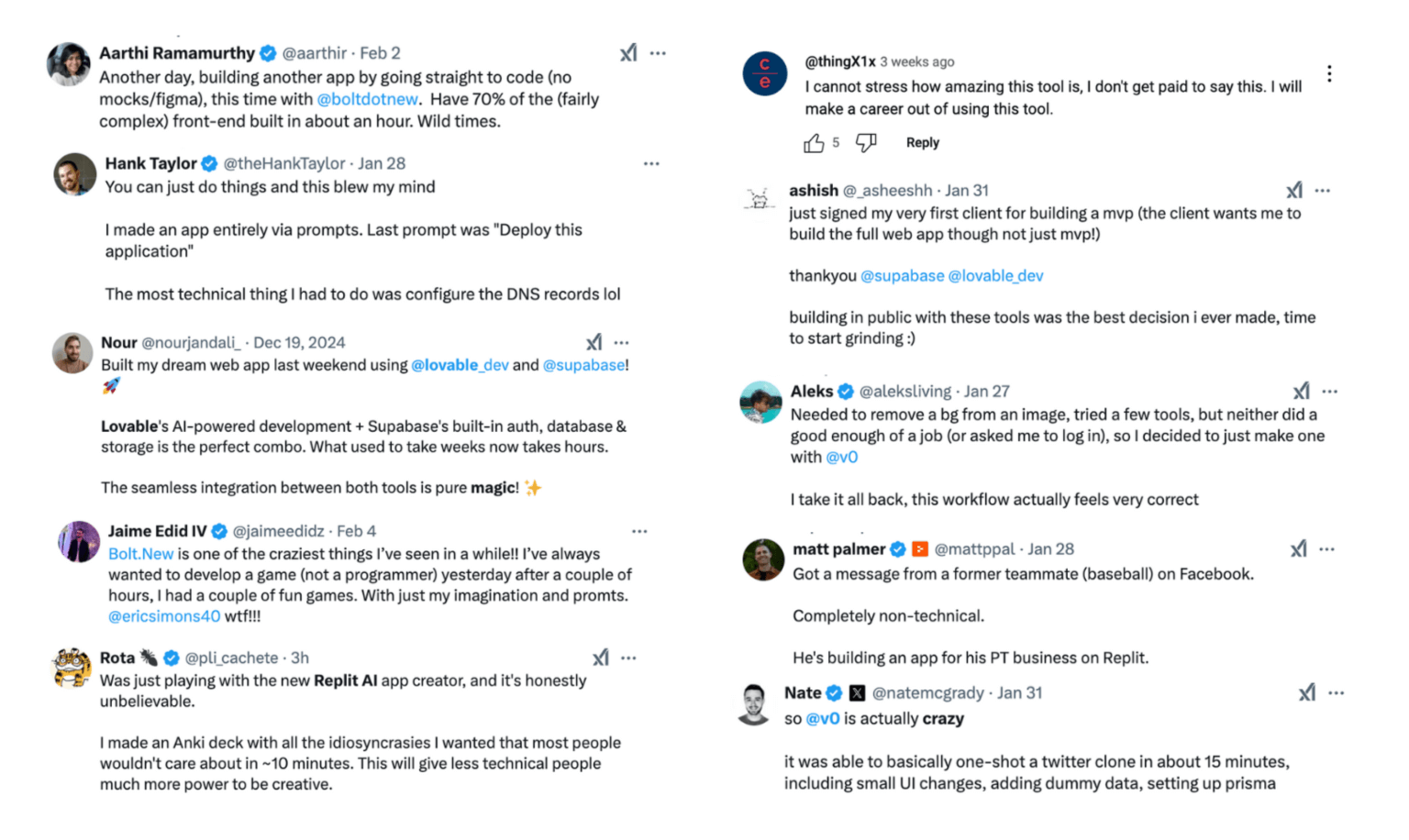
Source: a16z
The most successful consumer users of Bolt tend to be product-minded thinkers: PMs and entrepreneurs who are used to writing product specifications and working with developers. For them, prompting Bolt is often faster than writing a JIRA ticket. Bolt is priced on usage, making it easy for individual users to try and scale up based on how much they build.
Developers
Developers use Bolt to accelerate prototyping and front-end development. While Bolt is not yet optimized for editing large-scale legacy codebases, it’s well-suited for greenfield projects, smaller applications, internal tools, and feature mockups. In one particular example, a web development agency reported turning $7 of inference cost into five-figure client work. While not a replacement for traditional IDEs yet, it can be used as a force multiplier, especially when paired with other tools like Cursor for editing complex codebases.
Enterprise
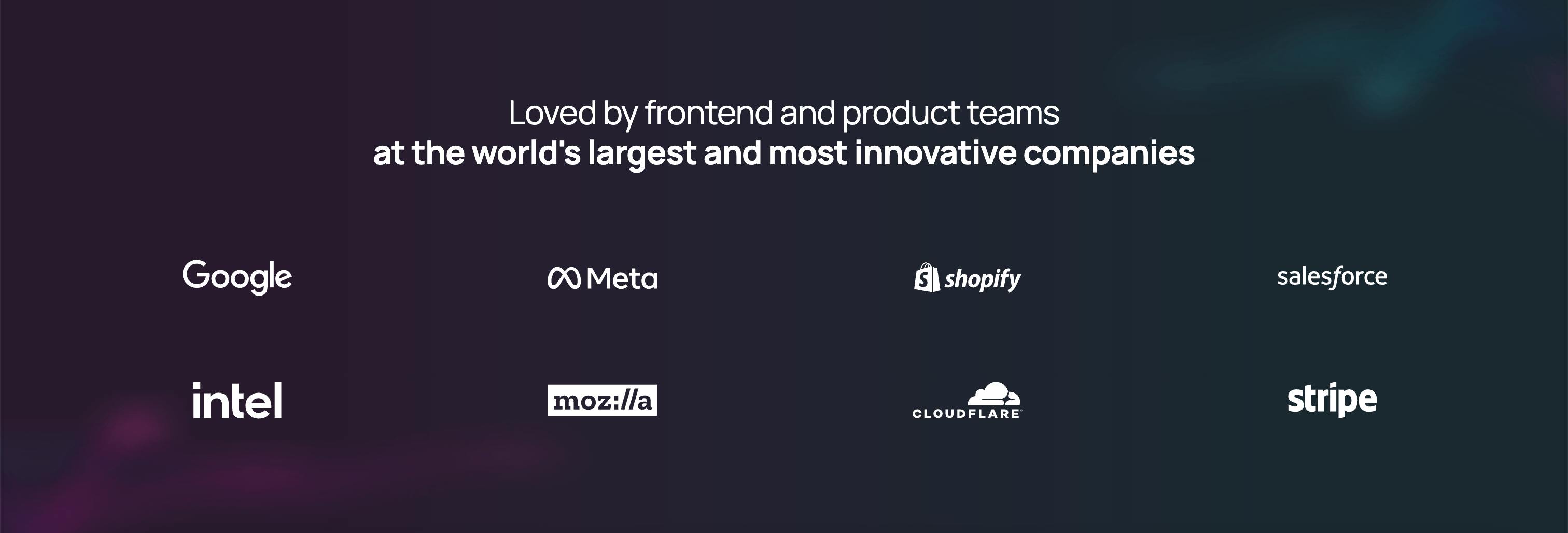
Source: Stackblitz
StackBlitz is used by engineering teams at companies like Google, Meta, and Shopify for debugging, onboarding, and interactive documentation. It eliminates the need for remote environments by running full-stack apps entirely in the browser, making it ideal for reproducible sandboxes and tutorials. StackBlitz is especially valuable in large organizations with complex toolchains, where the ability to share preconfigured development environments saves significant time and reduces friction.
Bolt is increasingly used across non-technical enterprise functions. Product teams use Bolt for prototyping— generating live versions of features for testing and iteration before involving engineers. While it’s not yet suited for large legacy codebases, it excels in greenfield workflows. Bolt is also used by AI research groups like Anthropic, who rely on it as the only open-source, production-grade codegen platform to benchmark new models.
Market Size
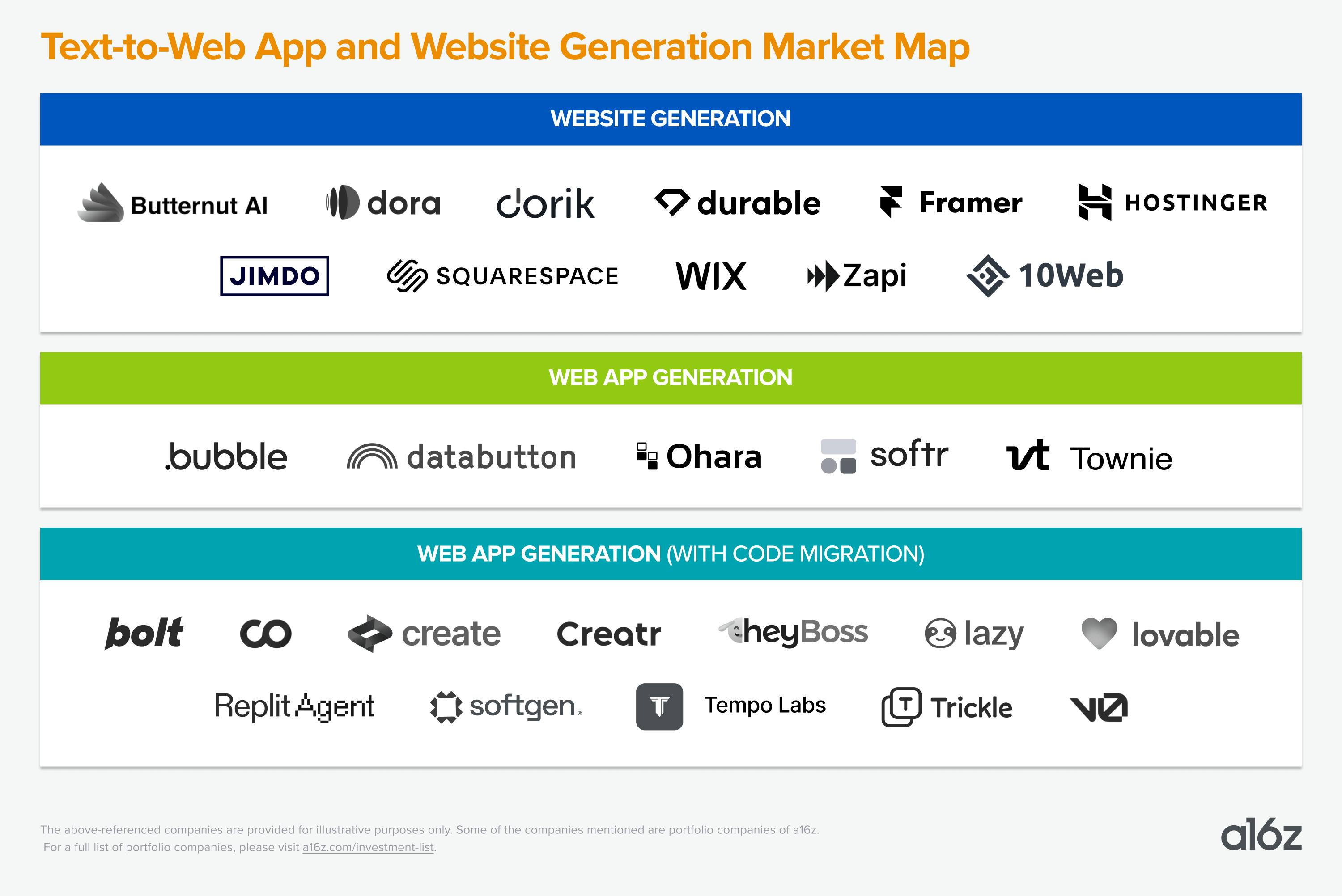
Source: a16z
Bolt and StackBlitz sit at the intersection of IDEs, web development, and AI code generation tools. In 2024, there were over 28 million software engineers worldwide, projected to reach over 45 million by 2030. With the proliferation of AI-native code generation tools in the early 2020s, non-technical users like product managers, marketers, and designers started building software too, expanding the total addressable market for web development tools. As of 2024, there were over 200 million active websites in the world, with over 250K new sites released on a daily basis.
In November 2024, Google CEO Sundar Pichai stated that AI systems were responsible for over 25% of the new code written for the company’s products. The global market size for AI coding assistants was estimated at $4.8 billion in 2023 and was projected to reach over $30 billion by 2032.
Competition
As of April 2025, the world's most popular IDEs by market share are Visual Studio (28.5%), Visual Studio Code (15.3%), Android Studio (11.2%), pyCharm (10.5%), and Eclipse (10%). In a January 2025 survey of 6.5K technology professionals, 90% reported subscribing to at least one LLM tool. 17% of the respondents were using AI-native coding agents like Cursor, with adoption among engineers rising to 21%. Replit*, v0 (Vercel), and Bolt also saw growing traction, with Bolt used by 5% of respondents.
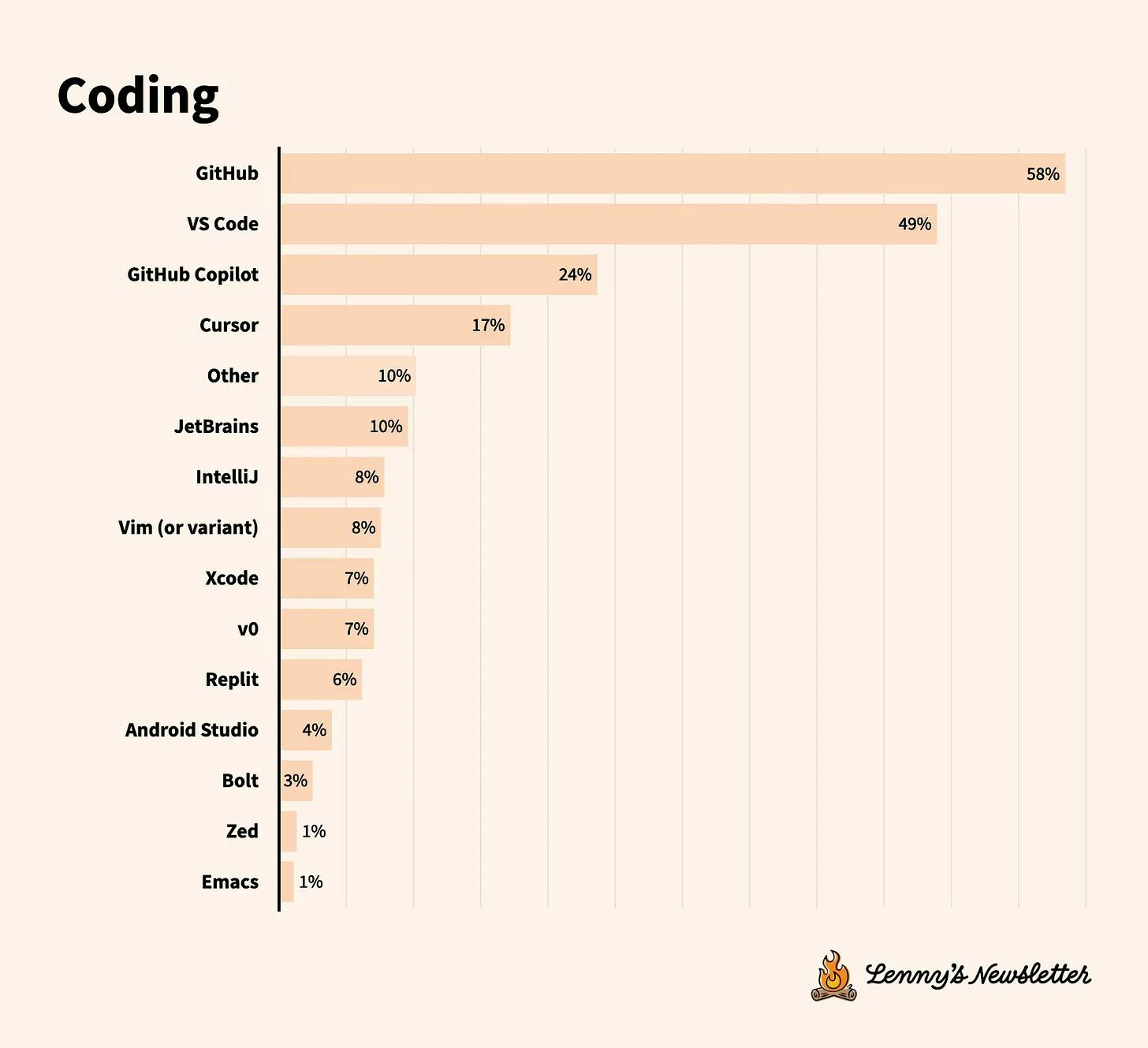
Source: Lenny’s Newsletter
Startups
Replit*: Founded in 2016, Replit is an online coding environment that lets users write, run, and deploy code directly from the browser. Originally focused on education and beginner developers, Replit has evolved into a full-stack collaborative IDE with AI features like Ghostwriter, its code completion assistant. Just like with Bolt, users can build applications across dozens of languages without setting up a local environment. The product supports deployment, package management, and live collaboration, and is increasingly used for teaching, prototyping, and solo development projects. Compared to tools like Cursor or Bolt, Replit sits between the two — more approachable than Cursor for beginners, but less abstracted than Bolt for non-technical users. As of April 2025, Replit has raised $222 million in funding.
v0 by Vercel: Founded in 2015, Vercel is a cloud platform-as-a-service company that developed and released the Next.js development framework in October 2016. In October 2023, Vercel announced v0, a generative UI platform. “v0 produces code using open-source tools like React, Tailwind CSS, and Shadcn UI.” While other generative code tools typically build front-end and back-end capabilities, v0 is focused on front-end user interfaces. In June 2021, it was reported that some of Vercel’s customers include McDonald's, IBM, GitHub, and Uber. Most likely, v0 is leveraging Claude 3.5 Sonnet, just like Bolt. As of April 2025, Vercel raised $563 million in funding, and was valued at $3.3 billion in May 2024.
Lovable: Founded in 2023, Lovable describes itself as an AI that provides a “full stack engineer.” Typical users of Lovable include product teams, entrepreneurs, indie hackers, product designers, and software engineers. However, Lovable is reportedly one of the more limited options in terms of code control, which is purpose-built for non-technical users. Lovable’s users speak positively about its integration capabilities. Supabase, for example, is an available option for database integrations in Lovable, same as in Bolt. Lovable has raised a total of $24 million as of April 2025, and reported $40 million ARR in April 2025, just five months after its launch, growing at a comparable rate to Bolt.
Cursor by Anysphere: Founded in 2022, Anysphere is the parent company of Cursor, an AI code editor built on VS Code. The product can autocomplete lines of code and implement the next logical edits. It can also connect to existing codebases and documentation. The product is used by engineers at companies like Vercel, Shopify, Midjourney, Perplexity, Ramp, and others. Typical Cursor users are software engineers looking for tools that make their lives easier. Users can interact directly with code, edit code install packages, and have more direct control over the development lifecycle. For use cases like deployment, users would pursue a traditional process for building out a database and hosting. Non-technical users would likely have a harder time using Cursor compared to other tools. Cursor is built on Anthropic’s Claude 3.5 Sonnet. Anysphere has raised $173 million in funding as of April 2025.
Windsurf by Codeium: Codeium announced Windsurf in November 2024. The product is an AI-powered code editor developed by Codeium, designed to streamline the software development process. Windsurf’s AI agent is Cascade, which provides multi-file, multi-edit capabilities. Like Cursor, Windsurf is built on top of VS Code, offering intelligent autocompletion, code generation, in-editor AI chat, and context-aware code modifications. It integrates with existing codebases, making it easier to navigate, refactor, and generate code efficiently. Windsurf is built on Anthropic’s Claude 3.5 Sonnet. In April 2025, it was reported that OpenAI was in talks to acquire Codeium for $3 billion. Codeium has raised a total of $244 million in funding as of April 2025, and has reached $40 million ARR in February 2024.
Incumbents
GitHub Copilot: GitHub was acquired by Microsoft in 2018, and subsequently launched GitHub Copilot in June 2021. The pair programmer was originally trained on OpenAI’s Codex model, described as a “descendent of GPT-3.” As of February 2025, GitHub Copilot could be used with models such as GPT 4o, Claude 3.5 Sonnet, Gemini 2.5 Flash, and others. Copilot can be used in IDEs such as Visual Code, Neovim, VS Code, or any JetBrain IDE.
In November 2022, a lawsuit was filed against Microsoft, GitHub, and OpenAI claiming that, because Copilot was trained on billions of lines of other people’s code available on the internet (like GitHub repos), it was effectively piracy. Though Microsoft and GitHub had attempted to get the lawsuit thrown out, that effort was dismissed in May 2023. As of July 2024, most of the claims that GitHub Copilot was copying code unlawfully had been dismissed. Just two allegations related to open-source license violations and breach of contract remained active in the lawsuit.
In February 2024, GitHub announced a more powerful version of its Copilot tool called GitHub Copilot Enterprise. It is generally available and serves as an assistant for developers, allowing them to familiarize themselves with new codebases and ask questions about private and public code. Copilot Enterprise can be customized to adapt its chat conversations to an organization’s repository so responses can be customized to the organization’s internal knowledge base. Additional features include providing coding suggestions and other comments in real-time as developers work, allowing developers to search through code repos, and analyzing code differences for developers to understand code changes.
Visual Studio IntelliCode: While GitHub Copilot is also available in Visual Studio and VS Code, in July 2018, Microsoft launched IntelliCode to offer AI-generated code assistance and auto-completion for Python, TypeScript/JavaScript, and Java. Unlike Copilot, which leverages external models, IntelliCode was historically powered by “a large-scale transformer model specialized for code usage (GPT-C).” In October 2022, one Visual Studio blog quoted Microsoft documentation that described IntelliCode’s infrastructure, but has since been obfuscated:
Business Model
StackBlitz operates a multi-tiered SaaS model across its three products: StackBlitz (IDE), WebContainers (runtime), and Bolt (AI agent). Customers pay for access based on usage, team size, and security needs.
StackBlitz and WebContainers offer free personal plans for hobbyists and open-source contributors. Paid plans start at $18 per month for individuals (Pro), $55 per month per user for small teams, and custom pricing for larger enterprise deployments. Enterprise plans unlock features like self-hosted and VPC installations, GitHub Enterprise support, and dedicated solutions engineers. WebContainers also offers API-level access for embedding runtime environments into other developer tools, priced separately based on usage and integration depth.
Bolt generates revenue by following a usage-based pricing model driven by tokens — units of text processed by the Claude 3.5 Sonnet model, which powers the system. Users purchase monthly token allotments, which are consumed during code generation, editing, and deployment. Plans start at $20 per month for 10 million tokens and scale up to $200 per month for 120 million tokens, with token allowances resetting monthly. Team plans follow a similar structure, charging per user based on monthly token usage. Tokens cover both input and output, and reflect underlying compute costs from model inference. Enterprise customers receive custom pricing and infrastructure options through StackBlitz.
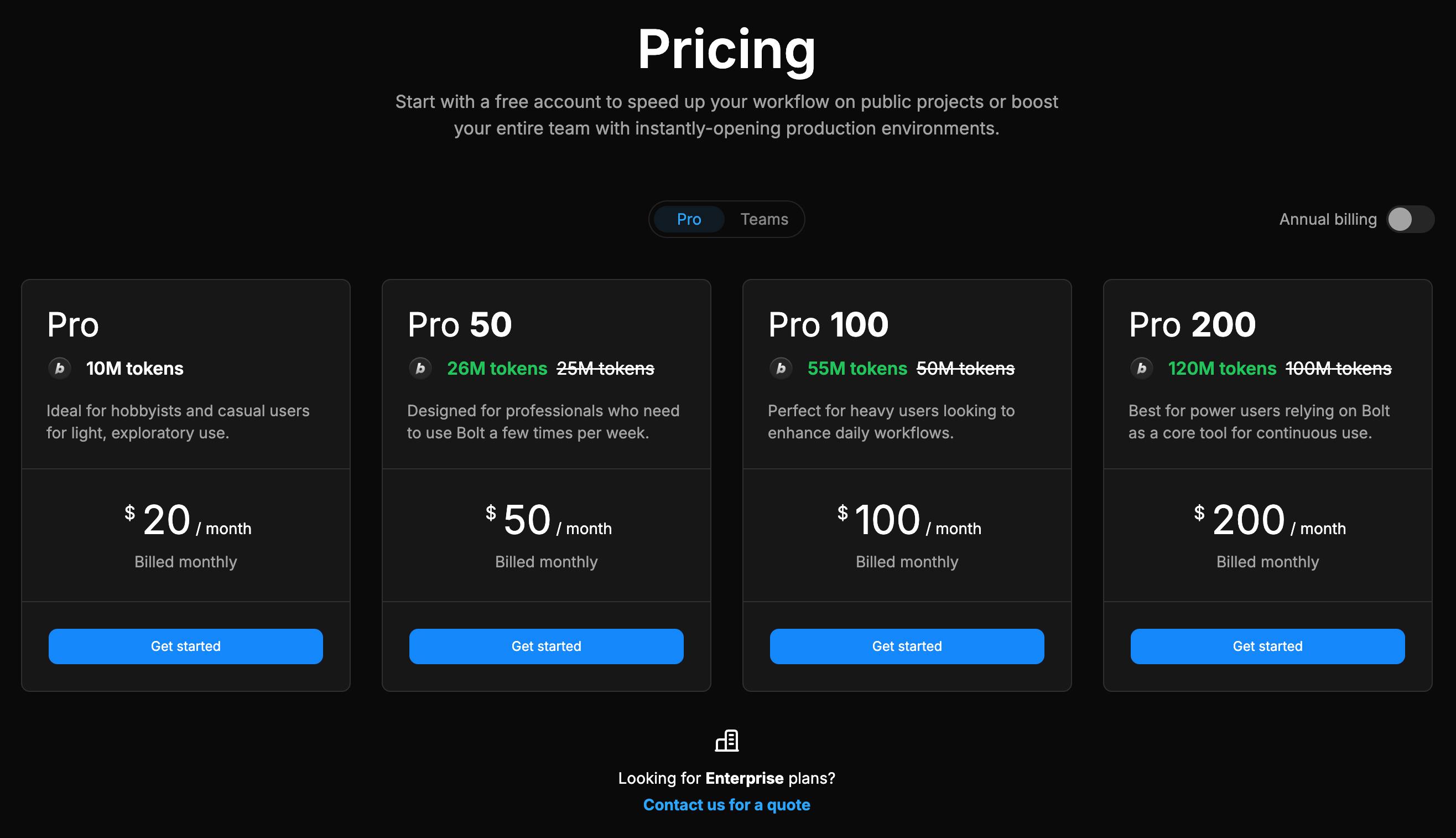
Source: Bolt
Based on Anthropic’s published pricing for Sonnet 3.5 (batch processing) — $1.50 per million input tokens and $7.50 per million output tokens — Bolt’s $20/month Pro plan costs between $22.50 and $45 in raw inference spend, depending on the ratio of input to output tokens. This implies StackBlitz has either negotiated preferential rates through volume discounts or blended usage across plans. As Simons put it, “Selling inference is our revenue model today… and we were the first to really figure this out.”
Traction
Before Bolt, StackBlitz had built a strong user base of over 3 million developers across 2K companies, including Google, Cloudflare, and Uber. However, it struggled to monetize, generating less than $1 million in ARR. Despite powering core developer workflows like debugging, rapid prototyping, and tutorials, the product’s open-source nature and limited commercial model constrained its revenue potential.
Everything changed in October 2024 with the launch of Bolt. The team shipped it without any marketing, just a single tweet. On launch day, Bolt added $60K in ARR. The following day, it added another $80K. What followed was what founder Eric Simons described as “true virality across channels”: the product spread across Twitter, Reddit, YouTube, and TikTok, with creators posting demos of the platform spinning up applications. The product’s usage was so explosive that it temporarily maxed out Anthropic’s GPU capacity — Anthropic’s CEO Dario Amodei described this as the fastest growth they’d seen for any customer. Simons described Bolt’s launch as an “overnight success seven years in the making.”
Within two months, Bolt had scaled to $20 million in ARR. By March 2025, that figure reached $40 million, with over 3 million registered users and more than 1 million monthly active users. The user base spans developers, product managers, founders, marketers, and designers, many of whom had never written code before Bolt. In March 2025, Netlify announced that over 1 million websites had been deployed by users of Bolt. The company is forecasting $100 million in ARR by the end of 2025, driven by growing usage in both consumer and enterprise environments. In 2025, Stackblitz was recognized on the Forbes AI 50 List and Wing VC’s Enterprise Tech 30.
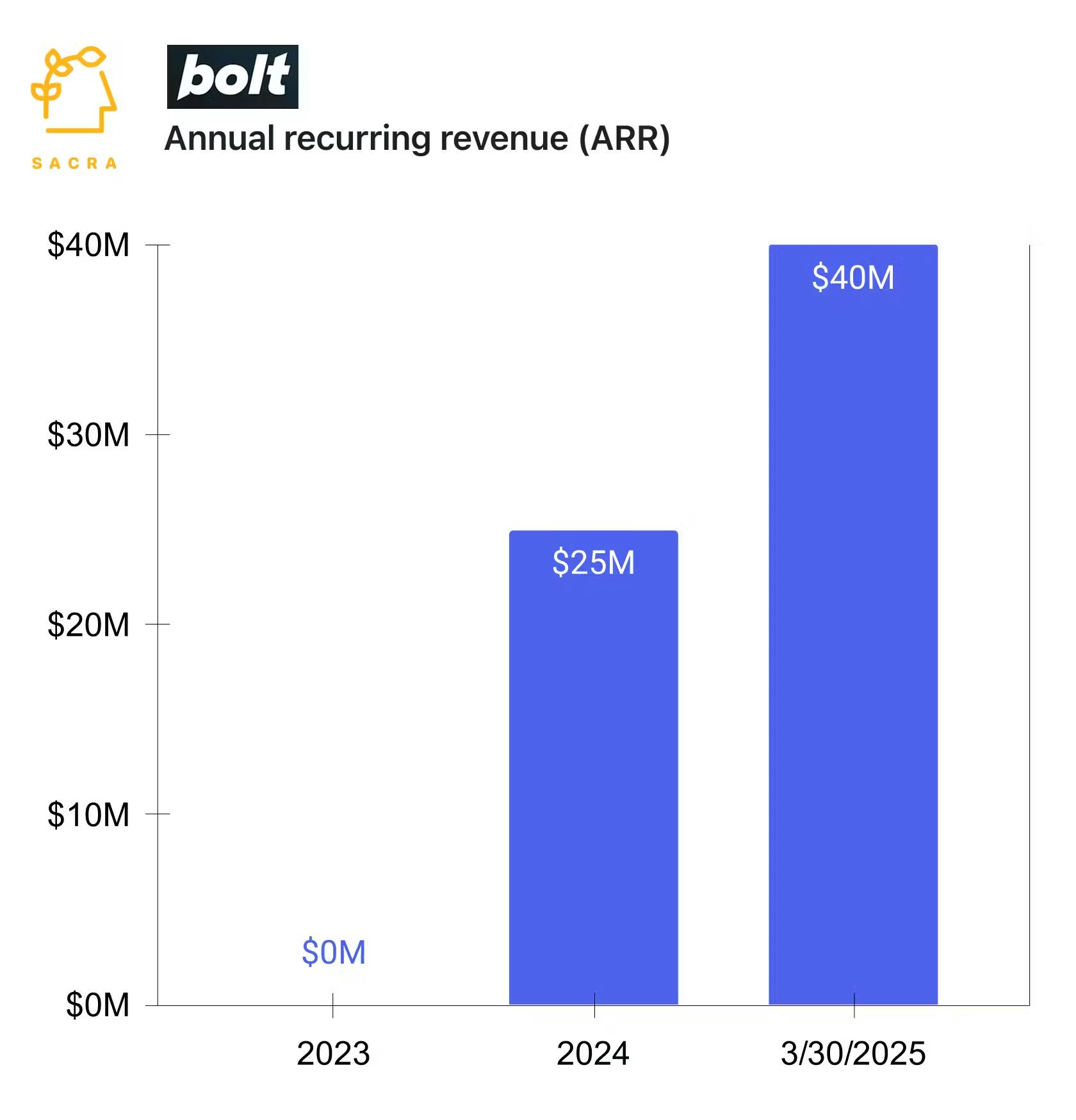
Source: Sacra
Valuation
In January 2025, StackBlitz raised a $105 million Series B round at an undisclosed valuation. The round was led by Emergence Capital and GV, with Madrona, Mantis and Conviction participating. Simons reported that StackBlitz was valued at $700 million at the time of the deal. Joe Floyd of Emergence has joined the company’s board following the investment. Prior to this, StackBlitz raised a $22 million Series A round in November 2024, and a $7.9 million seed round in April 2022, bringing its total funding to $135 million as of April 2025.
At the time of StackBlitz’s Series B round in January 2025, its post-money valuation was $700 million and ARR was estimated at $40 million in March 2025, implying a 17.5x revenue multiple. As a proxy, Gitlab, Microsoft and Google are comparable companies that are publicly traded.
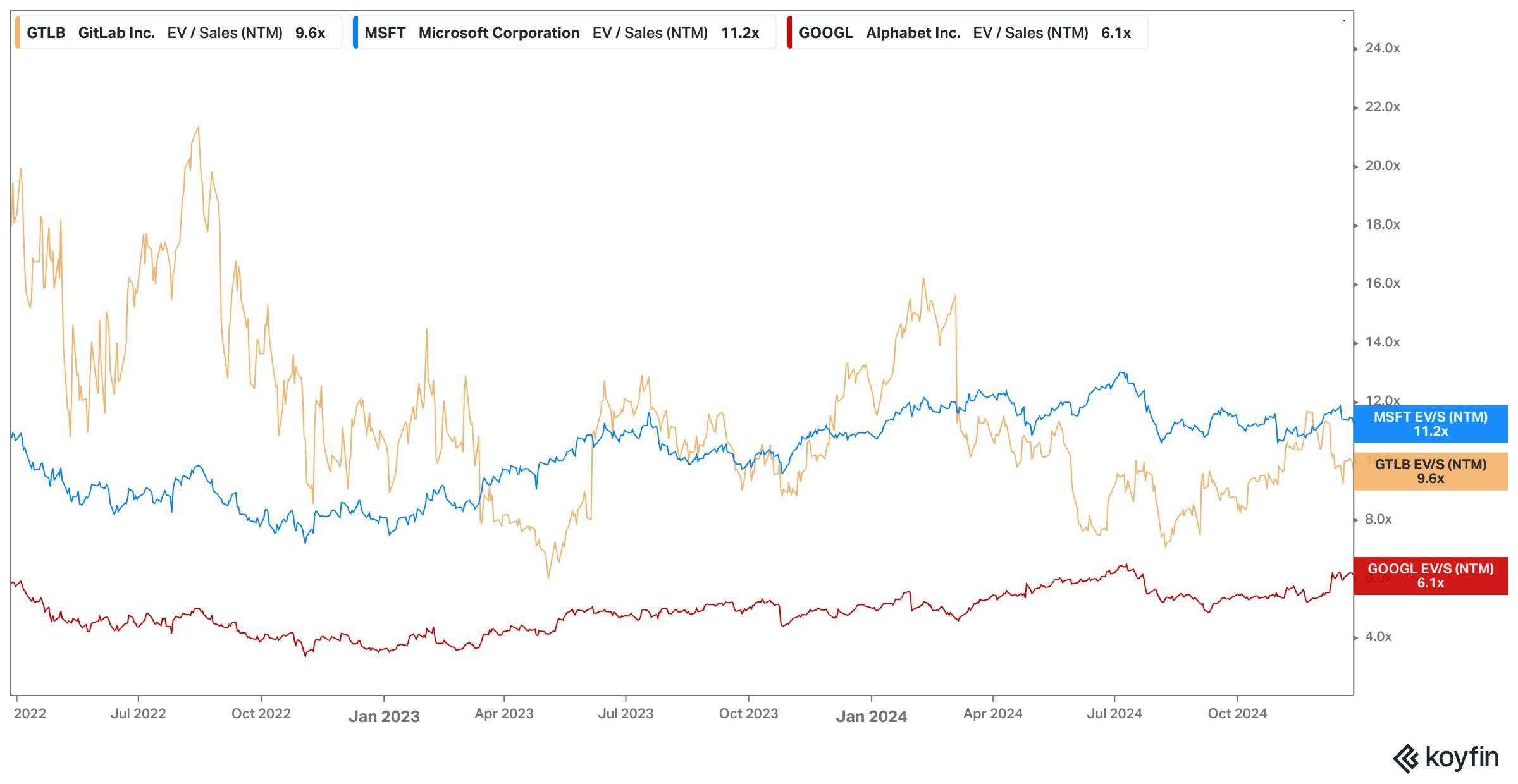
Source: Koyfin
Using these companies as a benchmark gives a range of revenue multiples: Gitlab at 9.6x, Microsoft at 11.2x, and Google at 6.1x. As a growth-stage developer tooling company, StackBlitz’s implied 17.5x revenue multiple at the time of its Series B exceeds those of mature public peers. This premium reflects investor confidence in StackBlitz’s platform differentiation, capital efficiency, and product-market fit.
Key Opportunities
The Consumerization of Software Development
The shift toward AI-native development environments is unlocking a new class of software creators: product managers, designers, founders, marketers, and other non-technical operators. Today, 67% of Bolt users are not developers. This signals a broader redefinition of software creation, from a developer-dominated process to one where the PM writes code (prompts) directly, skipping the traditional JIRA ticket loop. As LLMs like Claude Sonnet 3.5 continue to improve, and frontend logic continues moving to the client-side, more non-technical users will be empowered to build production-grade applications.
As Simons put it, “The entire software world order is going to get rewritten.” Aside from making development more accessible, tools like Bolt are reshaping who builds software and how teams are structured. In this new model, technical experts focus on complex, non-repeatable problems, while non-technical users own increasing parts of the build process. This shift isn’t yet reflected in most company organization charts, but Simons argues that it will be.
Industry Partnerships
StackBlitz has long benefited from close relationships with the developer ecosystem, and Bolt is now building its own. Its core integration with Anthropic’s Sonnet 3.5 has become a competitive advantage. Bolt was one of the first products to scale usage-based inference as a business model, and it has since become a proving ground for frontier labs and researchers to test their LLM quality. Anthropic itself now uses Bolt to test its new models.
As of April 2025, Bolt supports native integrations with Netlify (for deployment), Supabase (for database and authentication), Stripe (for payments), Expo (for mobile apps), and Figma (for importing designs into code). These integrations lower the friction required to go from prototype to live product. Internally, the team is developing a Slack bot, which will allow product teams to request features directly in a Slack thread and have the bot implement the change autonomously in Bolt. GV led StackBlitz’s Series B in January 2025, which could signal a potential distribution or cloud partnership with Google may be on the horizon.
Bolt Builders
In March 2025, Simons announced that Bolt is building a services marketplace that connects users with certified “Bolt Builders” for live help when they get stuck. Sessions are expected to cost $50 per hour and target users building tools like marketing sites, internal dashboards, and lightweight apps. This adds a new monetization layer beyond tokens and subscriptions while also increasing user retention and satisfaction. For non-technical users in particular, access to expert support could be the difference between abandoning a project and completing it.
Key Risks
Moving Beyond Prototyping
Bolt excels at spinning up greenfield applications from natural language prompts, but that strength can also be a weakness. Most users today rely on Bolt for prototyping, website scaffolding, or internal tool experiments. For teams with large, production-grade codebases, Bolt is not yet a fit. As Simons notes, “If you have a large existing code base… you’re going to need something like Cursor”. Without deeper collaboration, versioning, or production-grade tooling, Bolt risks becoming a powerful playground that users don’t fully graduate from. Escaping this will require investment in performance, integrations, and team workflows.
Competition
The market for AI-native development tools is becoming competitive. Bolt is competing with startups like Cursor, Replit*, and Lovable, as well as incumbents like GitHub and Microsoft, who are rapidly integrating Copilot into the broader development lifecycle. While Bolt has strong early momentum and a differentiated architecture through WebContainers, rivals are advancing on usability, performance, and model integration. As the category matures, pricing pressure on token-based inference models could also erode margins and reduce Bolt’s early advantage.
Platform Risk
Bolt is built on top of Anthropic’s Claude Sonnet 3.5, and its pricing, product capabilities, and performance are closely tied to the underlying model, introducing platform risk. Any changes in Anthropic’s pricing, access, or roadmap, especially if it moves up-market with its own tooling, could materially impact Bolt’s economics or differentiation. As of April 2025, OpenAI is in talks to acquire Codeium, a move which could push other model providers like Anthropic to vertically integrate by building or acquiring their own development environments, turning partners like Bolt into competitors.
Summary
StackBlitz builds browser-based developer tools, including the AI-powered IDE Bolt. Bolt runs entirely in the browser using WebContainers and Anthropic’s Claude Sonnet 3.5, allowing users to generate and deploy full-stack applications from natural language prompts. The product is monetized through token-based usage pricing and has grown to over 1 million monthly active users and $40M ARR as of March 2025.
Bolt is used by developers, product teams, and non-technical users for prototyping, internal tools, and simple applications. It integrates with services like Supabase and Netlify, and is now being used by Anthropic to test new models. Remaining questions include whether Bolt can move beyond prototyping into complex workflows, how it will compete with incumbents embedding LLMs into existing IDEs, and the risk of relying on external model providers.
*Contrary is an investor in Replit through one or more affiliates.








